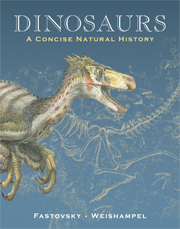Book contents
- Frontmatter
- Contents
- Why a natural history of dinosaurs?
- Dedication
- Part I Reaching back in time
- Part II Ornithischia: armored, horned, and duck-billed dinosaurs
- Part III Saurischia: meat, might, and magnitude
- 8 Sauropodomorpha: the big, the bizarre, and the majestic
- 9 Theropoda I: nature red in tooth and claw
- 10 Theropoda II: the origin of birds
- 11 Theropoda III: early birds
- Part IV Endothermy, endemism, and extinction
- Glossary
- Figure credits
- Index of subjects
- Index of genera
9 - Theropoda I: nature red in tooth and claw
- Frontmatter
- Contents
- Why a natural history of dinosaurs?
- Dedication
- Part I Reaching back in time
- Part II Ornithischia: armored, horned, and duck-billed dinosaurs
- Part III Saurischia: meat, might, and magnitude
- 8 Sauropodomorpha: the big, the bizarre, and the majestic
- 9 Theropoda I: nature red in tooth and claw
- 10 Theropoda II: the origin of birds
- 11 Theropoda III: early birds
- Part IV Endothermy, endemism, and extinction
- Glossary
- Figure credits
- Index of subjects
- Index of genera
Summary
Chapter objectives
Introduce Theropoda
Develop familiarity with current thinking about lifestyles and behaviors of theropods
Develop an understanding of theropod evolution using cladograms, and an understanding of the place of Theropoda within Dinosauria
Theropoda
Eating meat the theropod way
When dinosaurs got around to carnivory, they did it the theropod way: with steak-knife teeth, sinewy haunches, and grasping hands and feet tipped with scimitar claws (Figure 9.1 see p. 185). The combination was at once formidable and successful, and produced a rainbow palette of different types, among them coelophysoids, neoceratosaurs, carnosaurs, therizinosauroids, ornithomimosaurs, oviraptorosaurs, troodontids, dromaeosaurids, tyrannosauroids … and birds.
Grouped together as Theropoda (thero – wild beast; pod – foot), these dinosaurs have had a long evolutionary history extending back from the Late Triassic right up until the end, 65.5 Ma. Past that “end,” really, since birds are still very much with us. But in this chapter, we'll concentrate on non-avian (that is, non-bird) theropods, holding off on the avian side of the story until Chapter 10. Non-avian theropods (for simplicity, “theropods”) have been found on every continent including Antarctica (Figures 9.2 and 9.3).
Who are theropods?
Theropoda is a well-diagnosed, monophyletic group with abundant characters (Figure 9.4) within Saurischia (see introduction to Part III: Saurischia): theropods share their closest relationship with Sauropodomorpha and together form a monophyletic Saurischia.
- Type
- Chapter
- Information
- DinosaursA Concise Natural History, pp. 186 - 211Publisher: Cambridge University PressPrint publication year: 2009

